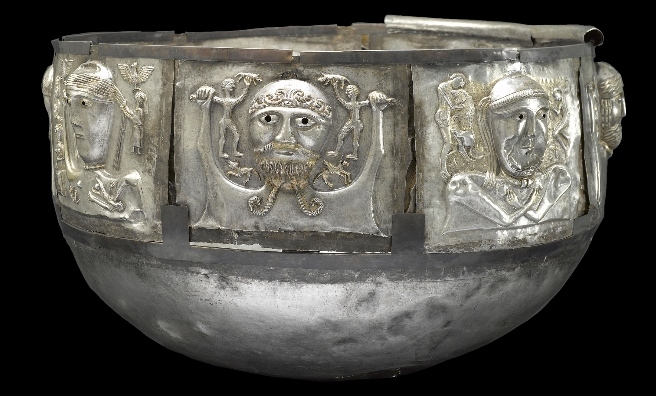Major National Exhibition To Celebrate The Celts

This autumn, the British Museum, in partnership with National Museums Scotland, will stage the first British exhibition in forty years on the Celts – Celts: art and identity.
Celts: art and identity opens at the British Museum on 24 September and will tell the story of the different peoples who have used or been given the name ‘Celts’ through the stunning art objects that they made, including intricately decorated jewellery, highly stylised objects of religious devotion and the decorative arts of the late 19th century which were inspired by the past.
In March, 2016, the exhibition will open at the National Museum Scotland and, as part of the National Programme activity around the exhibition, two rare Iron Age mirrors will tour museums across the UK.
Barbarians, far removed from the civilised world of the Mediterranean
Today the word ‘Celtic’ is associated with the distinctive cultures, languages, music and traditions of Scotland, Ireland, Wales, Cornwall, Brittany and the Isle of Man.
Yet the name Celts was first recorded thousands of years earlier, around 500 BC, when the ancient Greeks used it to refer to the peoples living across a broad swathe of Europe north of the Alps. The Greeks saw these outsiders as barbarians, far removed from the civilised world of the Mediterranean.
The Celts left no written records of their own but archaeology is revealing new insights into how they lived.
The exhibition will include iron hand-bells used to call the faithful to prayer, the horde of gold torcs found in a field at Blair Drummond by a metal detectorist on his first outing, elaborately illustrated gospel books telling the story of Jesus’s life and beautifully carved stone crosses that stood as beacons of belief in the landscape.
In addition, an exceptionally rare gilded bronze processional cross from Tully Lough, Ireland (AD 700-800), will be displayed in Britain for the first time.
The pre-Roman peoples of Western Europe
The name Celts disappeared from use after the Roman period but it was rediscovered during the Renaissance. From the sixteenth century, it became increasingly used as shorthand for the pre-Roman peoples of Western Europe and in the early 1700s, the languages of Scotland, Ireland, Wales, Cornwall, Brittany and the Isle of Man were given the name ‘Celtic’.
Today, the word Celtic continues to have a powerful resonance. “The word Celtic brings together a series of moments across the history of western Europe when particular communities made art and objects that reflect a different, non-Mediterranean, way of thinking about the world,” said Neil MacGregor, Director of the British Museum.
“New research is challenging our preconception of the Celts as a single people, revealing the complex story of how this name has been used and appropriated over the last 2,500 years.
“While the Celts are not a distinct race or genetic group that can be traced through time, the word ‘Celtic’ still resonates powerfully today, all the more so because it has been continually redefined to echo contemporary concerns over politics, religion and identity.”
‘The history of the peoples who became known as Celts’
Gordon Rintoul, National Museums Scotland Director, said: “The exhibition explores the history of the peoples who became known as Celts and examines the powerful objects created and used by them.
“I am delighted that this collaboration with the British Museum has allowed us to present a stronger, more rounded exhibition than either of the institutions could have achieved on their own.
“I am sure that audiences in Edinburgh and London will find much to engage, enthuse and inspire them.”
For more information, click here.
- A detail of the Tully Lough Cross, AD 700-900. Copyright National Museum of Ireland
- The Hunterston Brooch, made of silver, gold and amber, from south west Scotland AD 700-800
- Riders of the Sidhe – John Duncan’s 1911 painting of the Fairies who inhabited the Celtic Otherworld. Copyright Dundee City Council
- The Balmaclellan Mirror, one of the Iron Age mirrors which will tour the UK as part of the national programme of activity around Celts: art and identity. Photo copyright National Museums Scotland
- The Gundestrup Cauldron, 100 BC – AD1. Photo copyright The National Museum of Denmark
- A detail of the Gundestrup Cauldron, 100 BC – AD1. Photo copyright The National Museum of Denmark
Reflecting on the Celts
As part of the national programme of activity around Celts, from Autumn 2015 to Autumn 2016, two Iron Age mirrors, one discovered in England and one in Scotland, will tour the UK.
Metal mirrors were first made around 100 BC, when they might have held a special kind of power in a world where reflections could otherwise only be glimpsed in water.
Venues include:
- Lichfield Cathedral
- Littlehampton Museum
- Old Gala House
- Inverness Museum and Art Gallery
- The McManus: Dundee’s Art Gallery and Museum










